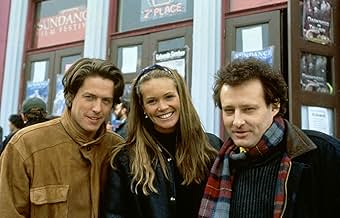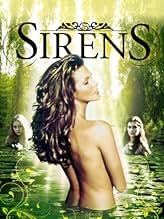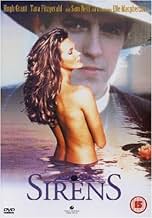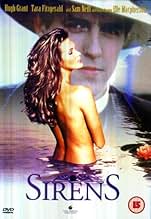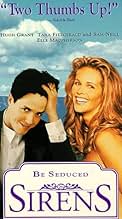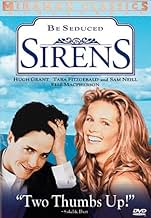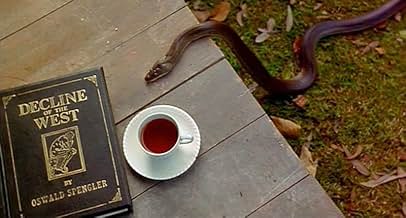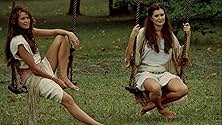When a painting is termed blasphemous, a young minister and his wife visit the artist... and the three sexually playful models living with him.When a painting is termed blasphemous, a young minister and his wife visit the artist... and the three sexually playful models living with him.When a painting is termed blasphemous, a young minister and his wife visit the artist... and the three sexually playful models living with him.
- Awards
- 1 win & 4 nominations total
Tziporah Malkah
- Pru
- (as Kate Fischer)
- Director
- Writer
- All cast & crew
- Production, box office & more at IMDbPro
Featured reviews
It is not the bosoms, really. No, there is an earnest quality here that is dependent on performances and landscapes and an essential moral tale than on the bounteousness of bums and bosoms frolicking in Australia. Neil is always good, Tara Fitzgerland is fine, and that often one-note Hugh Grant works perfectly as a priggish English priest who opens up ever so slightly when all is said and done. And much is said and some is done. There is some absolutley wonderful photography and some perfectly awful and obvious photography that would make Hallmark blush. Pretty good script with the story wandering about more than a bit. Shorter would have been better and the blue shots of nude statuary of indifferent quality by this nice but hardly profound Australian artist(on whose life and an episode therein, is it based)could have been a one-shot affair for my money. But I liked it for the performances.
I never heard of this film until the director for our theater company mentioned it as a possible project to adapt to live theater. I have to say when I first viewed the film I was a bit shocked for personal reasons. We have a fairly small group and if taken directly it would mean I would be playing one of the nude models. After studying the film's critiques and background I slowly came around to appreciate the film's merits, if not completely comfortable with the nudity. The point is that the nudity is not suppose to be comfortable from the audience point of view. The story takes place in an almost mystical world untarnished by outside influences and taboos. It is indeed a wonderful Eden. As an actress I had to be comfortable within the Eden created on stage, despite being uncomfortable in front of fellow "actors" and the audience. This has become one of my favorite films for helping me grow as an actress and as a member of the audience.
"Sirens" seems to have touched a nerve here. Some reviewers dismiss it as derivative soft-core drivel. Others love it. It probably helps to know that there's little derivative about the story-it's based on real people and a real incident. Sam Neill's character--Norman Lindsay--was real. Lindsay, a prolific artist and novelist, was also a libertine living a Hugh Hefner lifestyle when the rest of the world was awakening from the Victorian Age. "Sirens" was filmed at the Lindsay home and gallery, a 40-acre estate now run by the Australian National Trust. The artworks are all Lindsay's. And the storyline is based on an incident in which the Anglican Church dispatched a cleric to convey concerns about "The Crucifixion of Venus." As for the plot, it's simply a humorous retelling of what might have been--with lots of voluptuous nudes and erotic symbolism tossed in for good measure. Yes, it's all quite predictable. You know five minutes into the film that the Converters will become the Converted. But it's a fun ride getting to that inevitable destination. `Sirens' is not for everyone. If full-frontal male and female nudity offends, you will be offended. If ridiculing the Church or its values offends, you will be offended. And if the notion that the cure for a boring marriage is a little extra-marital dalliance offends, you will truly be offended. Otherwise, it's a little erotic gem and a great way to start an even better evening. :)
While this film is often not taken seriously because of its explicit nudity, it is in fact one of the most thought-provoking commentaries on religious values I have ever seen on the screen. This film provides us with the stark contrast of the repressed preacher from London and the artist's three models in rural Australia, a throwback to Shakespeare's "Green World." The fulcrum of this contrast is the preacher's wife, being pulled in both the oppressive, "moral" direction by her upbringing and her husband and the free and expressive direction of the artist. The breathtaking cinematography and stunning visual symbolism of this film contribute to make it into a powerful attack on the Christian moral code that dominates western thinking. I have been scoffed at on more than one occasion for praising Sirens, but I left the theater questioning my own views about what is and is not moral. The fact that this film's sexual content seems to invalidate it as art in many people's eyes merely underscores the value of its message. Along with Sling Blade, Sirens to me stands as the most provocative film about morality made in the 1990's. A solid 8 on a scale of 1 to 10.
I absolutely love this truly erotic film. An exploration of the awakening of a woman's sexuality, it is beautifully filmed and acted, and has many moments of wit and humour.
Some reviewers object to the heavily laden symbolism attributed to various parts, such as the shots of the snake. Well, symbolism is part of what good writers refer to as "subtext", it isn't too often seen these days, and is at least part of an attempt to have the film say more than what the characters say to each other. This is an artistically valid thing for any film to do, and raises the level of film culture generally, if only a little.
I have yet to see anyone commenting on the superb score - this wonderful music by Rachel Portman (whose work I otherwise do not know) is a delight from start to finish, and unlike most movie music, would stand on its own as a concert piece. The main theme, quirky, cheerful and rhythmically very interesting, seems to take as its inspiration the Vaughan Williams "March of the Kitchen Utensils" heard at the very start of the film as we follow Hugh Grant's feet walking through the art gallery, but it is very much an excellent piece of music in its own right. The "Dream Variations" are suitably dreamy, and coupled with the slow motion photography make for a superb piece of cinema.
John Duigan (writer, director) is not often mentioned in the same breath as other well known Australian directors such as George Miller or Peter Weir or Bruce Beresford, but personally I think he stands up with the best of them. A true Auteur (he has scripted most of the films he has directed) his films are always very interesting character studies. A more well known recent film he made was "The Leading Man" which starred Jon Bon Jovi as an American actor who comes to London to appear in a West End Play, and is "hired" by the director to seduce his wife. As in The Leading Man, Sirens is about the interactions between characters, this providing in my view more than enough in the way of plot and sub-plot. If Duigan's films always seem to be about human sexuality, well, after all, that is what drives most human relationships, whether we want to admit it or not. I think what stands out about Duigan's films, and particularly about Sirens, is their total honesty about human sexuality, without (and I know some will disagree) being excessively prurient.
A final line - I love the helicopter shot at the very, very end of the film. It is a beautiful, painterly landscape scene (which fades out *just* too soon), but one's love of its beauty is strengthened by one's admiration of the five actresses, who had to climb to the top of this sheer-looking rocky outcrop and remove all their clothes for the shot! They have my appreciation, and my sympathy!
Some reviewers object to the heavily laden symbolism attributed to various parts, such as the shots of the snake. Well, symbolism is part of what good writers refer to as "subtext", it isn't too often seen these days, and is at least part of an attempt to have the film say more than what the characters say to each other. This is an artistically valid thing for any film to do, and raises the level of film culture generally, if only a little.
I have yet to see anyone commenting on the superb score - this wonderful music by Rachel Portman (whose work I otherwise do not know) is a delight from start to finish, and unlike most movie music, would stand on its own as a concert piece. The main theme, quirky, cheerful and rhythmically very interesting, seems to take as its inspiration the Vaughan Williams "March of the Kitchen Utensils" heard at the very start of the film as we follow Hugh Grant's feet walking through the art gallery, but it is very much an excellent piece of music in its own right. The "Dream Variations" are suitably dreamy, and coupled with the slow motion photography make for a superb piece of cinema.
John Duigan (writer, director) is not often mentioned in the same breath as other well known Australian directors such as George Miller or Peter Weir or Bruce Beresford, but personally I think he stands up with the best of them. A true Auteur (he has scripted most of the films he has directed) his films are always very interesting character studies. A more well known recent film he made was "The Leading Man" which starred Jon Bon Jovi as an American actor who comes to London to appear in a West End Play, and is "hired" by the director to seduce his wife. As in The Leading Man, Sirens is about the interactions between characters, this providing in my view more than enough in the way of plot and sub-plot. If Duigan's films always seem to be about human sexuality, well, after all, that is what drives most human relationships, whether we want to admit it or not. I think what stands out about Duigan's films, and particularly about Sirens, is their total honesty about human sexuality, without (and I know some will disagree) being excessively prurient.
A final line - I love the helicopter shot at the very, very end of the film. It is a beautiful, painterly landscape scene (which fades out *just* too soon), but one's love of its beauty is strengthened by one's admiration of the five actresses, who had to climb to the top of this sheer-looking rocky outcrop and remove all their clothes for the shot! They have my appreciation, and my sympathy!
Did you know
- TriviaAlthough this is a work of fiction, it is about a real person. Norman Lindsay was a real-life artist and author in Australia during the early 1900s. Several of his books have been adapted into movies, including Age of Consent (1969).
- GoofsThe beautiful green steam locomotive that is seen in an early scene is a NSWGR 38 class, which first entered service in 1942. ( the movie is set around the year 1930. )
- Quotes
Sheela: [Anthony has just gone to the outhouse] I should have warned him about the redbacks.
Estella Campion: What are they?
Sheela: Small spiders with big teeth. They live under toilet seats usually.
Estella Campion: How do you know if they're there?
Sheela: By the screams.
- Crazy creditsThe situations depicted in this film are fictitious and do not represent events in the lives of Rose, Norman, Jane and Honey Lindsay.
- Alternate versionsAccording to the Technical Specifications link for this page on IMDB, there are two different versions of this film: "1 hr 38 min (98 min)," and "1 hr 34 min (94 min) (Canada)."
- ConnectionsEdited from A Steam Train Passes (1974)
- SoundtracksGrey Funnel Line
Written by Cyril Tawney
Dick James Music, Ltd.
Performed by Silly Sisters
Courtesy of Chrysalis Records, Ltd.
- How long is Sirens?Powered by Alexa
Details
- Release date
- Countries of origin
- Language
- Also known as
- Sirenas
- Filming locations
- Production companies
- See more company credits at IMDbPro
Box office
- Gross US & Canada
- $7,770,731
- Opening weekend US & Canada
- $34,299
- Mar 6, 1994
- Gross worldwide
- $7,770,731
Contribute to this page
Suggest an edit or add missing content


